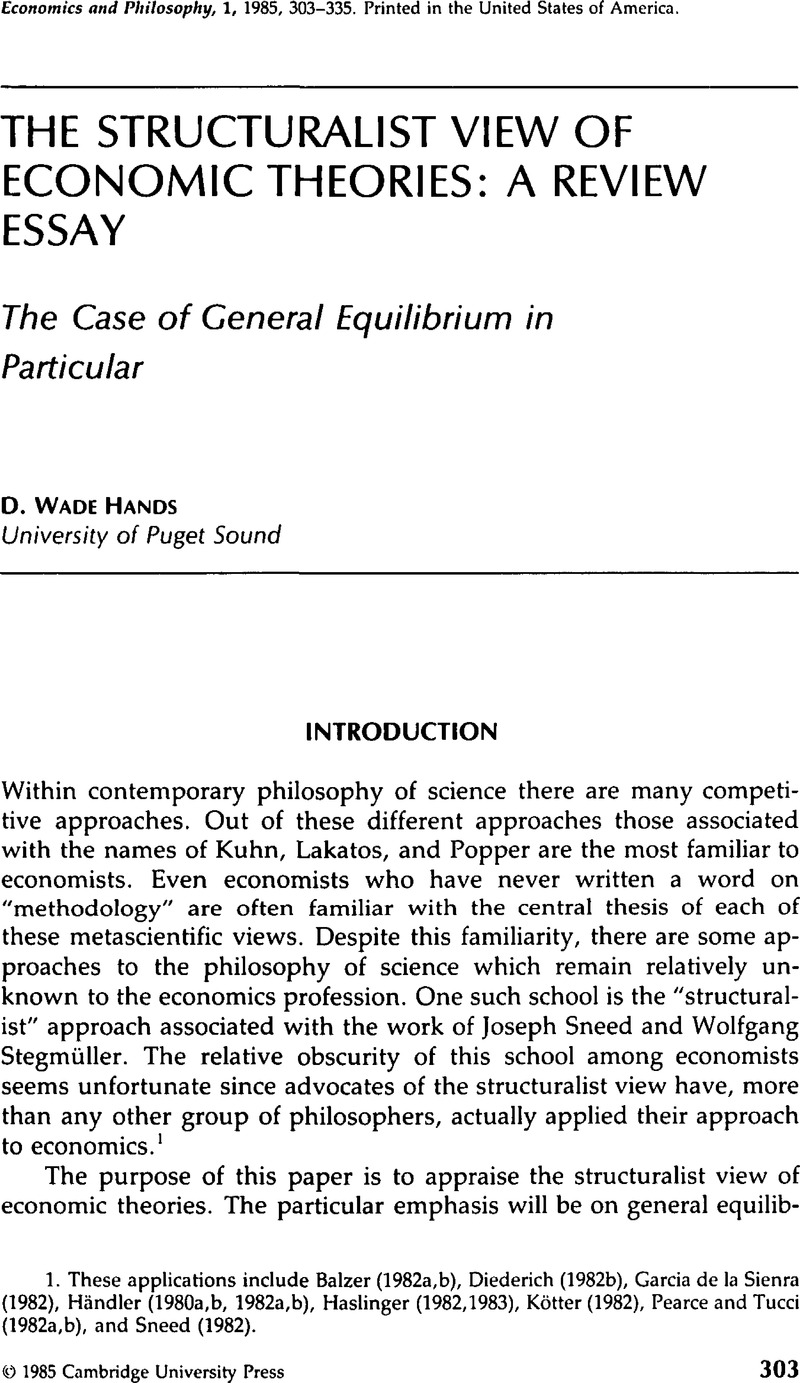Crossref Citations
This article has been cited by the following publications. This list is generated based on data provided by Crossref.
Hands, Douglas W.
1985.
The logical reconstruction of pure exchange economics: Another alternative.
Theory and Decision,
Vol. 19,
Issue. 3,
p.
259.
Caldwell, Bruce J
1988.
Developments in Economic Methodology with Implications for Political Science.
Politics,
Vol. 8,
Issue. 2,
p.
43.
Diamond, Arthur M.
1988.
The Empirical Progressiveness of the General Equilibrium Research Program.
History of Political Economy,
Vol. 20,
Issue. 1,
p.
119.
Janssen, Maarten C. W.
and
Kuipers, Theo A. F.
1989.
Philosophy of Economics.
p.
183.
Hausman, Daniel M
1989.
Economic Methodology in a Nutshell.
Journal of Economic Perspectives,
Vol. 3,
Issue. 2,
p.
115.
Salanti, Andrea
1991.
Roy Weintraub's Studies in Appraisal: Lakatosian Consolations or Something Else?.
Economics and Philosophy,
Vol. 7,
Issue. 2,
p.
221.
Vilks, Arnis
1992.
A Set of Axioms for Neoclassical Economics and the Methodological Status of the Equilibrium Concept.
Economics and Philosophy,
Vol. 8,
Issue. 1,
p.
51.
Lind, Hans
1992.
A Case Study of Normal Research in Theoretical Economics.
Economics and Philosophy,
Vol. 8,
Issue. 1,
p.
83.
Hands, D. Wade
1994.
Restabilizing Dynamics: Construction and Constraint in the History of Walrasian Stability Theory.
Economics and Philosophy,
Vol. 10,
Issue. 2,
p.
243.
Hausman, D.M.
2001.
International Encyclopedia of the Social & Behavioral Sciences.
p.
4159.
Ruttkamp, Emma
2002.
A Model-Theoretic Realist Interpretation of Science.
p.
13.
WADE HANDS, D.
2008.
INTROSPECTION, REVEALED PREFERENCE, AND NEOCLASSICAL ECONOMICS: A CRITICAL RESPONSE TO DON ROSS ON THE ROBBINS-SAMUELSON ARGUMENT PATTERN.
Journal of the History of Economic Thought,
Vol. 30,
Issue. 4,
p.
453.
Hausman, Daniel M.
2010.
Philosophies of the Sciences.
p.
324.
Callebaut, Werner
2011.
Beyond Generalized Darwinism. II. More Things in Heaven and Earth.
Biological Theory,
Vol. 6,
Issue. 4,
p.
351.
Boldyrev, Ivan
and
Kirtchik, Olessia
2013.
General Equilibrium Theory Behind the Iron Curtain: The Case of Victor Polterovich.
SSRN Electronic Journal,
Hands, D. Wade
2013.
Introduction to symposium on ‘reflexivity and economics: George Soros's theory of reflexivity and the methodology of economic science’.
Journal of Economic Methodology,
Vol. 20,
Issue. 4,
p.
303.
Boldyrev, Ivan
and
Kirtchik, Olessia
2014.
General Equilibrium Theory Behind the Iron Curtain: The Case of Victor Polterovich.
History of Political Economy,
Vol. 46,
Issue. 3,
p.
435.
Hands, D. Wade
2017.
Revealed Preference, Afriat’s Theorem, and Falsifiability: A Review Essay on Revealed Preference Theory by Chr.
OEconomia,
p.
409.
Hands, D. Wade
2017.
Revealed Preference, Afriat's Theorem, and Falsifiability: A Review Essay on Revealed Preference Theory by Christopher P. Chambers and Federico Echenique.
SSRN Electronic Journal,
Garg, Nikhil
Goel, Ashish
and
Plaut, Benjamin
2021.
Markets for public decision-making.
Social Choice and Welfare,
Vol. 56,
Issue. 4,
p.
755.



